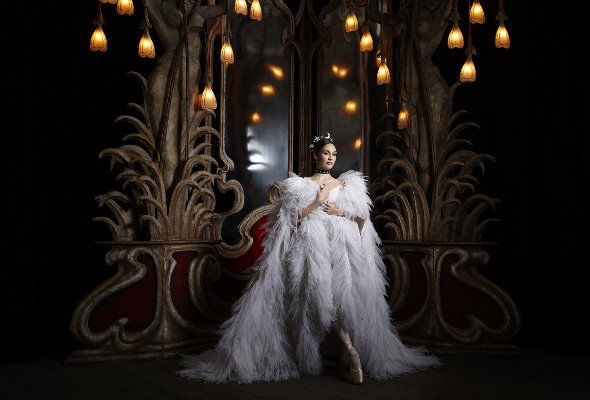State Theatre, Arts Centre Melboure
June 2011
By Brian Nolan
Conducted by Nicolette Fraillon and with indubitable and assiduous attention to detail, the rich melodic score of Franz Lehar was played to perfection by Orchestra Victoria as the Australian Ballet presented the ever popular and well-loved ballet The Merry Widow.
Choreographed by Ronald Hind in 1975 The Merry Widow became the first ballet to be created exclusively on the Australian Ballet. Hynds choreography is both poignant and creative as it flows with attractive transitions enabling the segments of pantomime he created to be humorous and delightfully adapted to what must be one of the most charming and emotional of any balletic musical scores.
Amid the superb belle époque costumes, with hats that could adorn any Melbourne Cup, and incredibly lavish art nouveau sets, the dancers waltz, spin, polka and can-can their way with consummate ease and complete freedom of movement. This is not a hard ballet to perform. There is no great degree of difficulty (though there are many lifts and a good series of tours in act two), but in this case it really does not matter as one is immediately absorbed into the majestic and surreal ambiance of the ballet and the story that unfolds.
In the grande waltz there was originally a greater use of the upper back, especially with the men, and in this rendition the polka needed much more use of épaulement with the shoulder and neckline.
In the leading roles of ‘Hanna’ and ‘Count Danilo’, Kirsty Martin and Robert Curran lacked that romantic sparkle which needs to leap from performer to audience. Kirsty’s dignified interpretation was mysterious and communicated the demureness of a woman of nobility, but she seemed slightly tense throughout. In my opinion she gave a considerate portrayal, danced with an assurance and extraordinarily technique, but not in keeping with some of her unique predecessors, as in Rowe and Fonteyn.
Robert Curran is the true noble classical “Prince”, but as ‘Danilo’ his palette was lacking in colour. He danced with clarity but lacked the passion and depth of character needed for the role. I feel that if Curran had more emotional and artistic involvement it would have assisted Kirsty Martin to stand beside Rowe and Fonteyn as a true icon in the role of ‘Hanna Glawari’.
Coquettish as well as charming, and in the true soubrette manner, Madeleine Eastoe was a wonderful ‘Valencienne’. Andrew Killian as her secretive French lover
‘Camille’, was flirtatious and mischievous. Their frivolity and unabashed desire for each other blended together to create charming pas de deux which radiated vigour, spontaneity and the odd bit of humour.
‘Baron Mirko Zeta’ portrayed by Colin Peasley was enthusiastically received and while Paul DeMasson’s ‘Njegus’ was likeable, I felt that the comedy the role should evoke was somewhat lacking.
In Act Two Chengwu Guo as the lead ‘Pontevedrian’ dancer was outstanding! His elevation, tricks and tours, unbelievable cossack jumps and turns displayed an ability that yells – Super Star (of the future). His horizontal barrel rolls were simply astonishing. I hope that the Australian Ballet manages to keep him, so that we can all be amazed with his potential wonderment!
The corps de ballet girls were outstanding. Their entrance with regal and majestic red character dresses in Act Two was exemplary. Along with the mesmerizing and haughty music it was one of the most charming, and engaging dances in the whole ballet.
The men were strong and the tours and turns were handled with fervent enthusiasm.In Act Three the men really stood out! The can-can girls were lacking somewhat in dynamics, range of motion (flexibility) and enthusiasm. The men had higher legs, and danced with more gusto and flair, all with a more flirtatious interpretation.
The marriage of Lehar’s music and Hinds choreography was perfect!
(Brian Nolan danced with the Australian Ballet in the 70’s & 80’s productions of The Merry Widow)
Photo: Kirsty Martin in The Merry Widow. Photo by Paul Empson

















